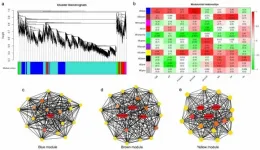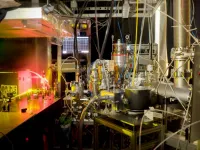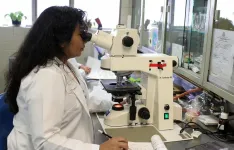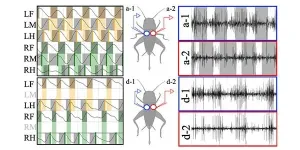Triggering tumor antiviral immune response in triple negative breast cancer
2021-01-14
(Press-News.org) HOUSTON - (Jan. 14, 2021) - Researchers at Baylor College of Medicine have discovered how therapeutics targeting RNA splicing can activate antiviral immune pathways in triple negative breast cancers (TNBC) to trigger tumor cell death and signal the body's immune response. A new study published in Cell shows that endogenous mis-spliced RNA in tumor cells mimics an RNA virus, leading tumor cells to self-destruct as if fighting an infection. Researchers suggest this mechanism could open new avenues for turning on the immune system in aggressive cancers like TNBC.
"We know therapeutics that partially interfere with RNA splicing can have a very strong impact on tumor growth and progression, but the mechanisms of tumor killing are largely unknown. In this study, we discovered that these therapeutics are modulators of anti-tumor immunity," said Dr. Trey Westbrook, corresponding author of the study, executive director of the Therapeutic Innovation Center (THINC) and McNair Scholar in Cancer Research at Baylor.
RNA splicing--the removal of non-coding introns--is often deregulated in tumors, leading to tumor growth but also making the tumor hypersensitive to spliceosome-targeted therapies (STTs). Triple negative breast cancer is one of many aggressive cancers that are responsive to STTs.
Westbrook's team wanted to understand how those drugs interfere with tumor progression. They found that in TNBC cells, STTs interfere with RNA splicing and cause a buildup of endogenous mis-spliced intron RNA in the tumor cell cytoplasm. Many of those aberrant RNAs will form double-stranded structures, just like an RNA virus. Antiviral immune pathways recognize the double-stranded RNA and then trigger apoptosis and send signals to the body's immune system to illicit an inflammatory response.
"Our study highlights an unanticipated way to activate an inflammatory response through specifically targeting cancer cells. These findings emphasize that when we think about the activity of cancer therapeutics, we need to look both at how they impact cancer cells as well as the effect this might have on the immune system," said Dr. Elizabeth Bowling, co-first author and member of the Westbrook lab.
"We now have a clearer understanding of how high levels of mis-splicing results in cellular stress in breast cancer. Furthermore, we suspect this RNA splicing stress may be present in many cancer types and disease states," said Dr. Jarey Wang, co-first author, member of the Westbrook lab and graduate of the Baylor Medical Scientist Training Program.
These discoveries may also lead to new biomarkers to select patients that respond to current immune-modulating therapies. Specifically, the research suggests that a tumor cell's endogenous mis-spliced RNA may be able to stimulate the immune system even without therapeutic (STT) treatment. The data shows a correlation between mis-spliced RNA and immune signatures, even in tumors that are typically immune-cold. The study authors hypothesize that this endogenous mis-spliced RNA could be used as a clinical biomarker to find which cancers will be sensitive to immunotherapy. The researchers say further study is needed to determine if STTs activation of anti-tumor immune pathways could make more patients eligible for immunotherapy.
"While immunotherapy is having profound effects for some cancer patients, it still only works in a minority of cancer patients. It's imperative that we learn how to broaden the swath of patients who might benefit from immunotherapy. This discovery uncovers a new mechanism by which cancers are speaking to the immune system and gives us strategies to exploit that for the benefit of patients," said Westbrook, Welch Chair in Chemistry, professor in the Verna and Marrs McLean Department of Biochemistry and Molecular Biology and Department of Molecular and Human Genetics and member of the Dan L Duncan Comprehensive Cancer Center at Baylor.
INFORMATION:
For a full list of authors and financial contributions, see the publication.
ELSE PRESS RELEASES FROM THIS DATE:
2021-01-14
A vector refers to an organism that carries and transmits an infectious disease, as mosquitoes do malaria.
Lead compounds are chemical compounds that show promise as treatment for a disease and may lead to the development of a new drug.
Antiplasmodial lead compounds are those that counter parasites of the genus Plasmodium, which is the parasite that infects mosquitoes and causes malaria in people.
The study findings were published in Nature Communications on 11 January 2021, at a time when malaria incidence generally peaks after the holiday season.
MOSQUITO INFECTION EXPERIMENT CENTRE
Professor Lizette Koekemoer, co-director of the WRIM and the National Research ...
2021-01-14
Recently, the innovation project watermelon and melon cultivation and physiology team of Zhengzhou Fruit Research Institute has made new progress in the metabolism regulation of sugar and organic acid in watermelon fruit. The changes of sugar and organic acid during the fruit development were analyzed and the key gene networks controlling the metabolism of sugar and organic acid during the fruit development were identified. These results provided a theoretical basis for watermelon quality breeding, which had important scientific significance for the development of watermelon industry and the improvement of watermelon breeding level in China. The related research results were published in the journals of Horticulture Research and Scientia Horticulturae.
The ...
2021-01-14
Research led by the University of Birmingham and Birmingham Women's and Children's NHS Foundation Trust has revealed new insight into the biological mechanisms of the long-term positive health effects of breastfeeding in preventing disorders of the immune system in later life.
Breastfeeding is known to be associated with better health outcomes in infancy and throughout adulthood, and previous research has shown that babies receiving breastmilk are less likely to develop asthma, obesity, and autoimmune diseases later in life compared to those who are exclusively formula fed.
However, up until now, the immunological mechanisms responsible for these effects have been very poorly understood. In this new study, ...
2021-01-14
Aerosols are suspensions of fine solid particles or liquid droplets in a gas. Clouds, for example, are aerosols because they consist of water droplets dispersed in the air. Such droplets are produced in a two-step process: first, a condensation nucleus forms, and then volatile molecules condense onto this nucleus, producing a droplet. Nuclei frequently consist of molecules different to those that condense onto them. In the case of clouds, the nuclei often contain sulphuric acids and organic substances. Water vapour from the atmosphere subsequently condenses onto these nuclei.
Scientists led by Ruth Signorell, Professor at the Department of Chemistry and Applied ...
2021-01-14
Leading cancer experts at the University of Birmingham have solved a long-standing question of how various types of mutations in just one gene cause different types of diseases.
A team of scientists at the University's Institute of Cancer and Genomic Sciences, led by Professor Constanze Bonifer, studied a gene known as RUNX1, which is responsible for providing instructions for the development of all blood cells and is frequently mutated in blood cancers.
The results of their research has shown that the balance of cells types in the blood is affected much earlier than previously thought, which is particularly important for families that carry ...
2021-01-14
Adaptability explains why insects spread so widely and why they are the most abundant animal group on earth. Insects exhibit resilient and flexible locomotion, even with drastic changes in their body structure such as losing a limb.
A research group now understands more about adaptive locomotion in insects and the mechanisms underpinning it. This knowledge not only reveals intriguing information about the biology of the insects, but it can also help to design more robust and resilient multi-legged robots that are able to adapt to similar physical damage.
The insect nervous system is comprised of approximately 105 to 106 neurons. Understanding ...
2021-01-14
Posidonia oceanica seagrass -an endemic marine phanerogam with an important ecological role in the marine environment- can take and remove plastic materials that have been left at the sea, according to a study published in the journal Scientific Reports. The article's first author is the tenure-track 2 lecturer Anna Sànchez-Vidal, from the Research Group on Marine Geosciences of the Faculty of Earth Sciences of the University of Barcelona (UB).
The study describes for the first time the outstanding role of the Posidonia as a filter and trap for plastics in the coastal areas, and it is pioneer ...
2021-01-14
Both past and present-day scientists have suspected the intestines of playing a role in various diseases. Present-day studies focus on the intestinal flora's role in physical diseases such as diabetes and overweight, while others seek to establish a connection between the intestinal flora and e.g. autism, schizophrenia and depression. But even modern-day scientists have difficulties studying the around 500-1000 different species among the approx. 100 billion active bacteria in our intestines.
Therefore, researchers from the University of Copenhagen have developed a ground-breaking technique that ...
2021-01-14
Roughly 8,200 years ago, the island of Yuzhniy Oleniy Ostrov in Lake Onega in the Republic of Karelia, Russia, housed a large burial ground where men, women and children of varying ages were buried. Many of the graves contain an abundance of objects and red ochre, signifying the wish to ensure the comfort of the buried also after death. Pendants made of elk incisors were apparently attached to clothing and accessories, such as dresses, coats, cloaks, headdresses and belts. Although no clothing material has been preserved, the location of the elk teeth sheds light on the possible type of these outfits.
A people of grooved elk tooth pendants
A study headed by archaeologist Kristiina Mannermaa, University of Helsinki, aimed to determine who ...
2021-01-14
Bacteria are likely triggering greater melting on the Greenland ice sheet, possibly increasing the island's contribution to sea-level rise, according to Rutgers scientists.
That's because the microbes cause sunlight-absorbing sediment to clump together and accumulate in the meltwater streams, according to a Rutgers-led study - the first of its kind - in the journal Geophysical Research Letters. The findings can be incorporated in climate models, leading to more accurate predictions of melting, scientists say.
"These streams can be seen all over Greenland ...
LAST 30 PRESS RELEASES:
[Press-News.org] Triggering tumor antiviral immune response in triple negative breast cancer








